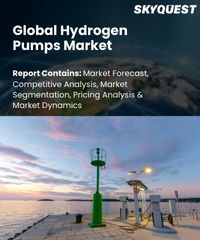
Report ID: SQMIG10B2063

Report ID:
SQMIG10B2063 |
Region:
Global |
Published Date: February, 2024
Pages:
157
|
Tables:
61 |
Figures:
80
Hydrogen Pumps Market size was valued at USD 0 Billion in 2023 and is poised to grow from USD 0 Billion in 2024 to USD 0 Billion by 2032, growing at a CAGR of 5.8% during the forecast period (2025-2032).
Hydrogen pumps, also known as hydrogen fueling station dispensers, are specialized pumps that are used to dispense hydrogen fuel into the fuel tanks of hydrogen fuel cell vehicles. These pumps are a critical component of the hydrogen fueling infrastructure, which is necessary to support the widespread adoption of hydrogen fuel cell vehicles. Hydrogen pumps work by compressing and dispensing hydrogen gas into the vehicle's fuel tank. The hydrogen gas is stored at high pressure in tanks at the fueling station, and the pumps use specialized nozzles and connectors to safely transfer the hydrogen gas into the vehicle's fuel tank. Hydrogen pumps are designed to deliver hydrogen gas at high flow rates and pressures, and they are typically equipped with safety features like automatic shut-off valves to prevent overfilling and other hazards. Hydrogen pumps are a key part of the overall hydrogen fueling infrastructure, which includes hydrogen production facilities, storage and transportation systems, and dispensing equipment like pumps and nozzles. The development of a robust hydrogen fueling infrastructure, including hydrogen pumps, is necessary to support the growth of the hydrogen fuel cell vehicle market and to help reduce greenhouse gas emissions from the transportation sector.
The global market for hydrogen pumps is expected to grow rapidly in the coming years, driven by increasing demand for zero-emission vehicles and government support for the development of hydrogen fueling infrastructure. The global market is still in its early stages, but it is expected to grow rapidly in the coming years. The primary end-use application for hydrogen pumps is in hydrogen fueling stations, which are used to supply hydrogen fuel to hydrogen fuel cell vehicles.
US Hydrogen Pumps Market is poised to grow at a sustainable CAGR for the next forecast year.
Our industry expert will work with you to provide you with customized data in a short amount of time.
REQUEST FREE CUSTOMIZATIONWant to customize this report? This report can be personalized according to your needs. Our analysts and industry experts will work directly with you to understand your requirements and provide you with customized data in a short amount of time. We offer $1000 worth of FREE customization at the time of purchase.

Report ID: SQMIG10B2063